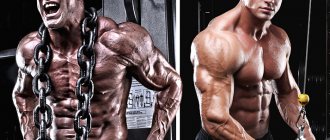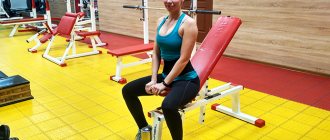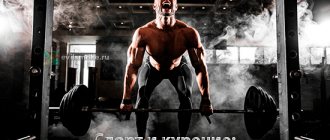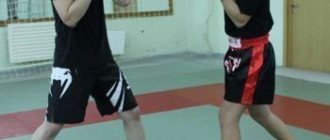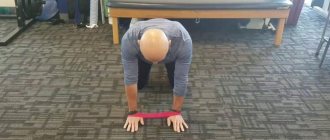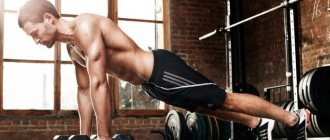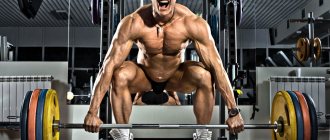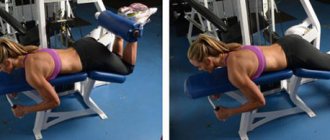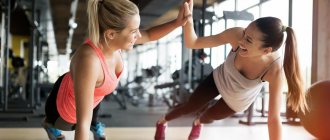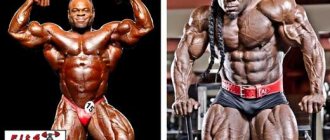Question: I can't go to the gym anymore and I don't have the space or money to do one at home. Tell me how to pump up at home without exercise equipment and can I build muscle without additional weights, barbells and dumbbells? Or am I completely lost?
Answer: Whenever someone asks me how to work out at home, without a gym (special equipment or even minimal free weights), my first reaction is to ask... why?
I mean, it doesn't take a genius to figure out that this is not a good environment for gaining muscle mass, so my first goal is to always try to solve any problem that is preventing me from achieving my goal.
Can't you find a way to get to the gym? Could you maybe cut back on your phone app purchases and instead use that money to buy a gym membership? Could you clear out some of the clutter in your basement or garage to free up some space for a full strength training session at home?
In very rare cases, people use the right way to pump up, and all problems are solved, and their muscles begin to grow with renewed vigor. But much more often the answer to all of the above is misunderstanding, refusal and the search for a miracle program of training and exercises for muscle growth. But in the end, disappointment comes from the wrong approach to business.
And this brings us back to the original question...
Is it possible to pump up at home? Yes! But…
The good news is that the answer to this question is definitely yes. You can train at home and still build muscle without the special machines found in gyms. The lack of free weights certainly doesn't help, but even with these conditions... you can achieve certain results.
The bad news is that it will be much more uncomfortable, much more difficult in the athletic aspect, and just much more difficult in general. That's why …
How to build muscles: basic requirements
Building muscle requires at least 2 fundamental principles.
- Progressive workouts that can stimulate growth. (A sound training plan = success.)
- A diet that can support muscle growth. (First of all, consume enough calories and protein).
As long as both principles work correctly, regularly and for a long enough time, the muscles will grow.
What should you do and use to make your muscles grow?
As you may have noticed, the main principles of muscle growth do not include a gym membership, training with free weights such as barbells and dumbbells, machines or additional equipment.
And this is because they do not play a decisive role in increasing muscle size and mass growth. These are just useful additions that can help speed up results and improve quality.
And not only in the sense that they will effectively train every muscle group and provide the muscle growth that you so desire. They simplify the progression of loads that is so necessary to stimulate muscle growth and progress in training both at home and in the gym.
That's why all gyms are filled with dumbbells from 2 to 45 kg + in 2 kg increments, barbells and plates from 2.5 kg to 20 kg (also in 2 kg increments); benches that can be adjusted to any angle; racks on which you can perform many exercises; complex, block and various exercise machines for each muscle group.
So I'm not going to lie to you here. If you want to build and pump up beautiful and strong muscles, then applying all of the above will be the best and most effective way to achieve this. Of course, you can do without something, but if you don’t have anything on this list, then this is a big problem.
But, as I already said, everything in this world is possible. There are a large number of different programs and workout options that can be used to build muscle at home without using equipment, and even the most controversial of them can work effectively when used correctly.
Contraindications to strength training without machines
Strength training without equipment is a high-intensity workout, so the main contraindications are heart problems, unregulated blood pressure, or other circulatory problems.
Some strength exercises are also inappropriate for people with back problems, including those with significant curvatures, because spinal curvatures incorrectly distribute the load during strength training and can lead to dangerous overload. High-impact exercise should also be stopped by people who experience pain during exercise.
People with injuries should also avoid strength training - although there are some exceptions. For some injuries, moderate-impact exercises may be recommended because they strengthen, for example, the deep muscles, which can take over some of the role of bones and joints that support the body during injury. The stronger the muscles, the better they stabilize and protect against further injury.
In addition, strength training can speed up the regeneration of muscle tissue, strengthening the tendons and skeleton, since it forces the body to constantly repair the areas that are involved in training. However, if you are injured, you cannot choose the exercises yourself. In this case, the course of exercise should be agreed upon with a doctor or physiotherapist.
Exercises for training at home without exercise equipment
For the first time, you have a wonderful inventory: whether you knew it or not... This is your own body weight . With it (+ a little creativity) you can do all sorts of exercises. Even the very first thing that comes to mind:
- Push-ups (and all kinds of variations);
- Pull-ups (and all kinds of variations);
- Horizontal pull-ups;
- Reverse push-ups;
- Headstand push-ups;
- Biceps curl;
- Bodyweight triceps exercise;
- Lunges (and all kinds of variations);
- Squats;
- Bulgarian squats;
- Pistol squats;
- Lying leg curl;
- Romanian deadlift on one leg;
- etc.
This is by no means a complete list of exercises. You'll find a bunch more.
But this is enough to create one of your workouts. There are enough exercises in this list to make working out at home truly effective for building muscle. And it will be without any additional equipment and without exercise equipment or going to an expensive gym.
Add, for example, a resistance band , and now you can do dozens of other exercises (close-grip rows, presses with a band, swings with arms forward and to the sides, biceps and triceps exercises, etc.) ...
So, the more exercise, the better. This is good news. Now for the less good news...
What is the best way to train without weights?
If for some reason you decide to train without weights, then you probably want to know the most effective and efficient way of this type of training. Well, here are some techniques. One set of one hundred repetitions. The first technique is to perform the exercises in the usual manner until failure. You can do 60, 80, maybe even 100 reps. Complete as many reps as you can. This technique will help you develop endurance. While it won't make your muscles huge, when you return to weight training and lower reps, you'll be surprised to see your muscles grow faster than before. A few years ago, several professional bodybuilders decided to try a technique they called "The One Hundred." They used lower weights on the apparatus and performed 100 reps on each exercise. As a result, certain physiological changes occurred in the muscles, which made the muscles more “responsive” to subsequent training with heavy weights. So it makes sense to try. Tense and freeze. Another way to get the most out of your non-weight-bearing exercises is to tense the muscles you just worked and hold that peak tension for at least ten seconds. Arnold often advocated holding the weight at the end point at the point of greatest tension, as well as the use of isometric tension. Isometric tension is simply contracting a muscle and holding that tension for some time, without moving. Arnold claimed that this technique gives the muscles a more “honed” shape, targets areas that cannot be worked with weight training, and also makes muscle contractions more intense during strength training. These are all good enough reasons to try this technique for yourself. Another use of this technique is to contract the muscles and hold tension before actually working them, in order to pre-fatigue them. For example, contract your pecs or triceps and maintain the tension for as long as you can, then immediately perform a set of push-ups. It’s a completely different feeling, isn’t it? This is a very tough technique that gives excellent results. Reducing rest time between sets. Assuming that you usually rest 60 seconds between sets, then reduce the rest time first to 45, then to 30 and gradually to 15 seconds. What if you did the exercises in one set, one after the other without a pause between them? And so several times! Circuit training is a very intense technique. Also try the following method - perform one set of the exercise to failure, rest for just a few seconds and perform another set. How many reps can you do on this second set? I think there are only four or five. You will see how the muscles begin to grow sharply after using this technique. It is also known as rest-pause. Invent your own types of weights. Why not just add a little extra weight? Even if they are not metal pancakes, your body will not feel any difference. Have someone put a stack of heavy books on your back and do push-ups. Instead of books, you can put your small child on your back. He will enjoy “riding a horse.” Place your wife or girlfriend on your shoulders (not both at once, otherwise you may have problems) and do squats. Or “donkey” calf raises. Use your imagination; you can almost always find a way to increase resistance. Use only one limb. How about using only one limb, such as one-legged squats, one-armed pull-ups, one-armed push-ups? You may have trouble keeping your balance at first, but this technique definitely makes the exercise much more challenging and helps you build more muscle mass. Slow movements. Slow motion training is becoming popular again. Try performing the positive phase of the movement in twelve seconds, and the negative phase in six. There is no need to fully straighten the limbs in the joints at the end point of the movement and rest at the lowest point. The transition from the positive phase of movement to the negative should be smooth. How many pull-ups can you do with this style? Perhaps a little, too much intensity. Contract your muscles additionally as you perform the reps. The latter technique is based on the so-called dynamic stress. “Dynamic” means “performed during movement,” while “tension” is simply muscle contraction. Thus, dynamic tension is an additional muscle contraction during movement. In martial arts, this technique is used to give more force to a strike. Let's try to apply this technique to our training without weights. Perform push-ups with clean form, squeezing your pecs, deltoids, triceps, biceps, latissimus dorsi and forearm muscles slowly and as hard as you can. When doing pull-ups, additionally contract your lats, biceps, triceps, even your pecs and forearms. When performing deep squats, tighten your quadriceps, hamstrings, gluteal and pelvic muscles, and calf muscles. Maintain a constant high level of tension, of course, mastering this technique will take you some time, but the incredible “pump” feeling and muscle growth it will give you is definitely worth it.
Progress will be difficult to achieve, but it is possible
Progress in these exercises (where the #1 goal is to gain muscle mass) can be difficult to achieve, especially as you get stronger. Because you can't adjust the weight you perform the exercise with to create a progression of loads that needs to create stress to stimulate muscle growth: you can't just add 2kg and move on to the next weight like you can with a barbell or dumbbells.
Luckily, this won't be a problem early on, as there are 2 great ways to increase your load.
The first step is to move from simple exercises to more complex ones (for example, from assisted pull-ups to simple pull-ups). Great. After this, progress in repetitions is necessary. For example, if you can only do 3 sets of 5 reps for some exercises, you can gradually increase the number of repetitions to 12 for 3 sets.
But at some point, the exercise variations will end and you will no longer be able to add reps, since there will be a high risk of starting to train for endurance rather than for muscle growth.
So what should you do then? Well, you either keep doing what you're doing and never get stronger, build muscle, or figure out a way to increase the load. For example…
- Sports vests with weights;
- Weighted belts;
- Stiffer rubber bands;
- There are rings, TRX loops and others;
- A backpack filled with books;
- Affordable and easily adjustable dumbbell sets designed to save space.
Depending on the specific exercises, there will almost always be some way to make them harder: adding some extra weight or simply making the exercises harder so that the load progresses and the muscles continue to grow.
You just need to think a little to understand the approach to each exercise you do. This is the whole key to effective training.
If you don't do this, you will end up like most people who work out at home without much thought about weights or special equipment... forever stuck at the same weight and muscle size, doing the same thing without changing anything in your training program .
Not fun at all!
Everyone who works out at home has different training conditions and equipment, and they all ask the same question... can my workouts be effective for muscle growth?
The answer obviously depends on what exactly (what equipment) the person will be working with. But if I had to just guess, I would say that in 99% of cases any exercise can be replaced by some other, similar one that could be performed in the conditions you need.
Four Intense Cardio Exercises for the Lower Body
- Jumper
- Skater
- Skier
- Sprinter
Image by sportwiki.to
You can use any variation of squats, lunges, and step-ups that can be performed fairly quickly and fall into the category of intense cardio exercises for the lower half of the body. Squat jumps are also an option if you're willing to do them. I also encourage you to do step squats whenever possible, as this exercise is quite safe and does not have a serious impact on the joints.
1. Jumper
This classic cardio exercise is extremely easy to do, works the entire body, and is relatively easy on the joints compared to other explosive exercises.
Image by sportwiki.to
Stand straight, keeping your feet together and your arms at your sides. While jumping, simultaneously spread your legs to the sides and raise your arms above your head (as far as you can, depending on the mobility of your shoulder joints). When in doubt, do jumping jacks: simply extend your arms straight out to the sides. This will give you the opportunity to move actively without putting too much stress on your shoulders.
Focus on the speed of your jumps and arm swings, not the height of your jumps, and continue to lean on your toes throughout the exercise. If you find this too difficult, modify the exercise by moving only one leg to the side at a time and raising the same arm; it is somewhat easier on the lower half of the body. If you have had an injury in the lower half of your body, you can generally just stand and move only your arms.
Arms and/or legs are swapped
Image by sportwiki.to
Cross your arms in front of your body at chest level. This activates and stretches the chest and posterior shoulder muscles to a greater extent, and seems preferable for people with shoulder pain. You can also cross your legs. Another option is to move your arms and legs as if you were skiing.
Turn on the squat
Image by sportwiki.to
Lower yourself into a squat to activate your thigh muscles and make the exercise more challenging. You can start with a wide stance and move your legs together into a squat (as shown in the illustration), or, conversely, you can start with your legs together and spread them out to the sides as you lower yourself into a squat.
Try jumping in a push-up position
Taking a prone position (plank on straight arms), jump your legs forward and backward without moving your arms.
Image by sportwiki.to
More difficult option: Place your hands as close as possible and keep your feet together (as shown in the illustration). Then jump, spread your arms and legs and lower your torso to the floor. After this, push up with an explosive movement and, lifting off the floor, bring your arms and legs together again.
2. Skater
Image by sportwiki.to
Like sprinting, jumping develops muscle power. Jumping from side to side activates fast-twitch muscle fibers, burns calories, increases your heart rate, and is good for your knees. Just jump sideways from one leg to the other. Start with small jumps (15 cm) and gradually increase their amplitude to 60 cm or more.
General requirements for all progressions:
- when landing, bend your legs at the ankle, knee and hip joints, move your pelvis back and keep your back straight;
- swing your arms in the direction of the jump;
- hold the landing for 1-2 seconds before jumping again.
Skater step
Image by sportwiki.to
Step to the side, crossing your front leg over your back leg. Having two points of support provides greater stability and support when you jump from one foot to the other. Repeat in the opposite direction.
Skater jump with rotation
Image by sportwiki.to
This variation has a rotational component as you open your hips and jump from one leg to the other. Jump back to the starting position, jump to the other side and repeat.
3. Skier's swing
Image by sportwiki.to
Skier's swings provide the same benefits as kettlebell swings, but without the need to swing a cannonball between your legs. The exercise is so named because when you perform it, your body resembles a skier flying down a mountain. It consists of the same elements as jumping jacks, except that your feet don't leave the floor as you raise your arms above your head. Thanks to this feature, the exercise has a relatively low impact on the joints and is well suited for high repetitions. Turning your arms inward, swing them back, behind your back, so that in the back position they are facing palms up and thumbs facing each other. In this case, the shoulder joints are in the most stable position. The movements are performed mainly in the hip joints, although the legs are slightly bent at the knees. Just try not to round your back in the lower position or arch your lower back in the upper position.
Skier's swing with diagonal leg position
Image by sportwiki.to
You can move one foot back slightly so that the toe of the back foot is in line with the heel of the front. The main load falls on the hip joint of the leading leg. This makes the skier's swings a little more difficult. You will have to move more slowly due to the need to maintain balance.
To achieve the desired effect in terms of speeding up metabolism and burning calories, you need to perform the skier's swings with greater speed and purpose, compensating for the lack of weights. Movement speed is the main compensator.
4. Sprinter
Everyone knows that there is no better way to get a flat stomach and get into good athletic shape than sprinting. But most people aren't in good enough shape to be sprinters to begin with, or they don't have the opportunity to be a sprinter, either at home or at work. If you live in a northern climate like I do, you're unlikely to see sprinters in the winter. This exercise serves as a substitute for real sprinting.
Image by sportwiki.to
From the starting position, take a step back with your right foot, move your pelvis back and lower your right hand to the inside of your left foot. The back remains straight. After a short pause, take an explosive step forward. Now, instead of returning to your stance, continue alternating between a step back and a step forward so that the foot of your left foot remains in place the entire time. Hold each pose for a brief moment before moving your leg. This exercise simulates the start of a sprint race, focusing on the gluteal and hamstring muscles. Complete all reps and then switch legs.
Sprinter's Lunge
Image by sportwiki.to
This option imitates running itself. The torso is kept closer to the vertical, as are the legs. The legs bend at the knees more, and there is a stronger impact on the hips. Essentially, you add to the back lunge the movement of the arms towards opposite legs. As you step back into the bottom of the lunge and your back knee almost touches the floor, your arm moves forward. Hold this position for a short time, then move in the opposite direction and repeat. The supporting leg remains in place all the time. Perform all repetitions on one supporting leg, and then switch sides. The exercise can be made more challenging by adding a jump at the top position so that the leading leg momentarily lifts off the floor and returns to its place, ready for another backward lunge.
Training program without iron
Whether you have access to a gym or not, it doesn't really matter, working out at home can be just as effective.
There are tons of exercises you can do without free weights, in the privacy of your own home, hotel room or office to build muscle and improve your fitness.
Of course, training with additional weights and machines is great, but the simple fact is that you can build muscle without additional equipment.
How to build muscle without exercise equipment at home?
Use these exercises!
Exercises that you perform only with your body weight go a long way in developing functional strength at any fitness level. Since you won't be using additional weights for these exercises, it's best to focus on a very fast pace and high number of repetitions to fully engage your muscles. Of course, technique always comes first, but in general, bodyweight exercises have a much lower risk of injury than free weights.
Below is a list of the 10 best exercises that will help you build muscles at home. You've probably heard of many of them, but I've added my own tips for improving your technique and approach.
Squats
Squats work 85% of the muscles in your entire body. Just think about it. The productivity of this exercise is many times greater than any other. Additionally, squats are known to promote greater testosterone production. If you want to build muscle mass, then this is definitely your option.
To perform a deep, proper squat, start with your feet wider than shoulder-width apart, toes pointing out slightly, and as you begin the squat, keep your back straight and focus on pushing your butt back and keeping your chest high. When you squat, bring your knees forward and outward, but not over your toes, and press your heels into the ground to maintain balance. If you need extra balance, move your arms forward. When the pace is fast and explosive, this extra balance can become very necessary.
You can do bodyweight squats every day if you want. You can also change up your squatting technique by trying single-leg squats or sumo squats (wide-legged).
Push ups
Push-ups are an upper body exercise. Anytime, anywhere, you can do push-ups and work your chest, shoulders, triceps and back muscles. Follow your breath and lower yourself until your chest touches the ground.
For variety, a wide stance will target the pecs more, while a close stance will increase resistance.
If you elevate your legs on a chair or wall and change the angle, you will work the upper pectoral muscle, increasing the difficulty.
Reverse push-ups
Using a chair, coffee table, or even a bed, you can always work your triceps and pecs with reverse push-ups. This is an excellent exercise, by doing which you will be able to see a beautiful and prominent horseshoe-shaped muscle on the back of your arm. Remember to keep your head straight so that your spine is in the correct position.
Wall Squats
Wall squats are a great way to work on your quads and endurance. With your back close to the wall and your arms at your sides, lower yourself down to create a 90-degree angle between your knees and the wall. You can't lean on your knees! Personally, I like to use the timer on my phone for this exercise. Start by trying the high chair exercise for 60 seconds or until you can no longer stand the burning sensation in your muscles.
Lunges
Lunges are one of the best exercises, but proper technique takes some practice, as with any exercise. People have a tendency to sway when they shift their body weight from one leg to the other. As you shift your weight forward to the other leg, remember to keep your back and shoulders straight; You'll also want to focus on moving your hips down toward the floor rather than forward—this will allow you to complete the rep with proper form.
Plank
Starting from your stomach, keep your spine straight and support your weight on your forearms, which at this point are on the floor and form a right angle with your shoulders. Pull your stomach in to increase the intensity. Planking is another exercise for which I recommend using a timer. Try it for 90 seconds and tell me you can't do core workouts at home.
Side plank
The concept of doing this is similar to the plank, but the difference is that the upper body should be supported by only one arm. The oblique abdominal muscles and core muscles are worked.
"Superman"
The expression that applies to this exercise is: “As it is heard, so is it written.” It will work your arms and lower back. Lie on your stomach, then reach forward and lift your arms, legs and head off the floor as if you were trying to fly, hold this position for a few seconds and lower down.
Crunches with leg raises
I like to combine crunches and leg raises to work my upper and lower abdominal muscles. Lie on your back with your heels flat on the floor, lift your knees toward your chest and do a crunch, squeezing your abs as your knees and chest touch each other. Then return to the starting position.
Burpee
A burpee is a multi-muscle movement that combines a jump with a push-up. This is a great option for working multiple muscle groups. The main thing to pay attention to is the lower back; Avoid bending your spine as much as possible when you squat and then jump up.
Circuit training
If you've been working out for a while and don't think bodyweight exercises are going to give you the muscle gains you're looking for, you can up the intensity of your home workout by doing circuit workouts. This will work on your muscles and endurance, add an aerobic element and really increase the difficulty of your workouts.
Circuit training constantly keeps you toned, heart rate and pulse accelerated, while one muscle group rests and another works hard. You will be amazed at how many physical results you can get in less time using this method.
When planning a circuit workout, it is important to turn off certain muscle groups to give them rest one at a time. So, if you start with push-ups, then move on to squats and abdominal exercises.
Conclusion
So now you have my favorite at-home exercises that build muscle without any equipment. They can help you get in shape and lose weight while improving your overall health and strength. No gym? No problem!
Workout training program for mass and strength
Do you want to build muscle mass and become stronger, but for some reason you can’t go to the gym and don’t have sports equipment? Then this article will be very useful for you. It describes in detail all the subtleties of the training process, observing which, you will confidently progress and rise to a new level in 2-3 months. All you need is a horizontal bar and parallel bars, which can be found in almost every yard.
Attention! We have released a new updated workout program for training on parallel bars and horizontal bars. It can be used as an alternative to the program below. We advise you to familiarize yourself with it, because... It's very effective and quite versatile!
Most inhabitants of sports grounds or simply horizontal bars and parallel bars have always been tormented by one question: “How to pump up?” Many of you have been training for more than one month/year and the muscles have already become quite accustomed and adapted to such loads, so giving them new stress and stimulus is extremely difficult, especially if you do not use weights and train only with your own weight (calisthenics). It is for such people that this Workout training program for mass and strength without weights is intended. By doing it, you will give your muscles a greater load and additional stress, which will subsequently have a mirror effect on the response of your muscles and give hypertrophied supercompensation. In this article, we will take a detailed look at and analyze a training program that is specifically designed to help you gain muscle mass and strength without the use of weights, working out only with your own weight (calisthenics).
The road to building a strong, healthy, and beautiful body rests on three pillars: nutrition, training and rest. If you adhere to a proper and balanced diet, exercise extensively and intensively, and also get regular and quality rest, the results will not be long in coming. But as soon as one of the three components falls out, your result can immediately stop, or even slide down completely. Therefore, always remember the “three pillars” and constantly adhere to the regime.
And we’ll start with perhaps the most important aspect that everyone who wants to build muscle mass should know. We will talk about proper nutrition for gaining muscle mass. Because Since this article is devoted exclusively to the training program, we will not dwell on nutrition for long. If you are interested in this question, all the information is described in the article “Nutrition for gaining muscle mass“. In this article, we will highlight only the most important and basic points:
- -Consume more calories than you burn (on average 300-500 Kcal).
- -Eat often (5-8 times a day).
- -Consume an average of 2 grams of protein per 1 kg of body weight.
- -Consume 6-7 g of carbohydrates per 1 kg of body weight.
- -Consume an average of 0.9 grams of fat per 1 kg (give preference to mono and polyunsaturated fats).
- -Drink an average of 2 liters of water per day.
- -Take vitamin and mineral complexes.
- -Add omega 3,6,9 fats to your diet.
- -Main sources of protein: chicken, beef, milk, eggs, cottage cheese and fish.
- -Main sources of carbohydrates: porridge (rice, buckwheat), durum pasta.
- -At every meal where there is meat, add herbs and vitamin C.
- -Your diet should include at least 1 serving of fruit.
- -Also include vegetables or salads in almost every meal.
Now we need to clarify the issue regarding rest. This is the next and very important aspect for building a strong and healthy body. Rest should be long and of high quality, this applies to sleep. Sleep 8-10 hours a night, and also allow yourself to take short naps during the day (at least 15-20 minutes). Your night's sleep should be sound and long. It is also recommended to do stretching before going to bed; it will stretch your muscles, as well as calm and prepare the central nervous system for rest.
Now we come to the most important part of this article. Before going straight to the main program, I would like to say a few more words. Your workouts should be 120%, that is, you should push yourself to the maximum (even more) in every workout. Only in this way and only in this mode are real changes possible. Don’t feel sorry for yourself and especially your muscles, because you can mock them to the fullest, if this really makes sense.
Workout training program for mass and strength without weights
In this program we will use approaches for a specific muscle group alternating several (different) exercises. Those. we will alternate two exercises (not to be confused with supersets) for one muscle group or muscle with a short rest interval. The essence of this combination is to perform two typologically different load rating exercises. The first exercise will be difficult (basic), and the second will be somewhat lighter in terms of load and impact on the muscles. In the first case, you should perform a small number of repetitions (strength work), and in the second, 2-3 times more repetitions than in the first exercise, but not less than 12 (endurance work). Training in this style allows you to target different muscle fibers (fast and slow). Also, this combination allows you to adapt to different stimuli and loads at the same time, which is extremely difficult for the body, and it receives an additional portion of stress, and as a result, an exaggerated response.
Goal: gain muscle mass and increase overall strength indicators. This Workout training program is designed for those who want to gain muscle mass and become stronger without the use of additional weights.
Number of repetitions . For each muscle group, do two paired exercises that differ in the type of load. The 1st approach is performed on average up to 6 repetitions (heavy), and the 2nd approach is performed from 12 to 20 repetitions, respectively (light).
Rest. Rest between paired approaches (heavy-light) for up to 20-30 seconds, and rest between main exercises (switching to another muscle group) should last within 1-2 minutes (only 1 time per workout).
Duration . On average, you need to train with this program for 2-3 months, but if your progress does not stand still, then you can safely continue training with it.
Recommendations. When you do heavy exercises, try to use forced repetitions. Let's say you did 4 repetitions yourself with all your might, ask your partner to help you do 2 more repetitions with little help (helping you a little). From such a blow, your muscles will definitely be in shock. As for light exercises (for quantity), here you can do a second delay at the peak of the contraction. This will allow more blood to flow into your muscles and, accordingly, the pump effect will improve; it will feel as if your muscles are about to burst.
Warm up. A prerequisite before performing the first approach in this program and more is a warm-up. Warm-up should be done always and everywhere, as the risk of injury is very high. Start with a regular run (within 5-10 minutes), you can finish the warm-up with the usual warm-up movements, and then you can start the main program.
MONDAY – (Biceps + Back)
- One-arm pull-ups (reverse grip) – 3 to 6
- Arm curls to parallel bars (reverse grip) - 3 15-20 times
+(additional*) — Arm curls to parallel bars (“Hammer” grip) 2-3 8-12 times
- Wide grip pull-ups (explosive tempo) – 4 x 6-12
- Pull-ups to parallel bars 4 to 12-15
+(extra*)- Pull-ups along the bar 2-3 max
Tuesday (Legs + Abs)
- Light cardio 3-7 minutes (to warm up joints)
- Sprint race 10-20 meters (uphill) – 3-5 races
*(in a week) Sprint race for 20-50m. (in a straight line) – 3-4 runs
- Leg raises on the horizontal bar (heavy) – 3 x 6-12 times
- Twisting or leg raises on parallel bars (light) – 3 x 12-20 times
WEDNESDAY (Triceps + Chest)
- Push-ups on one arm - 3 6-8 times
- Bench push-ups - 3 x 12-15 times
+(extra*) – Standing parallel bars push-ups 2-3 at max.
- Dips (with corner) 4 x 6-10 times
- Push-ups from the ground (wide arms) 4 to 12-15 (at speed)
+(extra*) Pull-ups from the horizontal bar (wide grip from above) – 2-3 to failure
FRIDAY (Legs + Shoulders)
- Single leg squats 4 to 6-8
- Speed squats – 20 sec
+(extra*) Lunges 3-4 x 15-20
Calf raises in support 3-4 x 20
- House push-ups 4-5 6-12 times
- Abduction of the arm to the side (with an expander) 4-5 12-15 times
+(extra*) Standing parallel bars push-ups “House” 2-3 to max
As you may have noticed, some of our workouts start with small muscles (biceps and triceps), rather than with large ones. This is done in order to pre-tire the arm muscles so that they are less involved in working the large muscles (back and chest). After all, without additional weights it is very difficult to load large muscles, and this method also allows you to pump up your arm muscles well. If, on the contrary, your arm muscles are well developed, but your back and chest are lagging behind (which is extremely rare), then you can change the order of the exercises and start your workout with those lagging behind.
Debriefing
(extra*) is an additional exercise that is used at your discretion to “finish” the muscle if you feel that you have not pumped up the muscle enough, and the additional exercise can be used as a replacement for the previous exercise. Those. in the first case, you perform an additional exercise in order to push the muscle to complete failure (if 2 exercises were not enough for you). In the second case, you can alternate exercises weekly, so that the muscle does not get used to one exercise so quickly.
If you manage to perform more than 6-8 repetitions in the first (heavy) exercise, then ask your partner to help you complicate/weight the exercise.
1- One arm pull-ups
Perform this exercise slowly and under control. If you do not have an elastic band or expander, then you can help yourself with two fingers, which will allow you to do the exercise correctly while maintaining your balance.
2- Bar curls
Try to lower yourself smoothly and under control (in the negative phase), and also pause for a second at the peak of the contraction. If it is difficult for you to do a large number of repetitions with one hand, you can perform this exercise with both hands, while changing the grip each new workout.
3- Hammer grip curls
In this exercise (as in the previous one), it is important to work exclusively with the biceps in order to maximally load the biceps and brachialis (the muscle under the biceps). What matters here is not quantity, but quality.
4- Pull-ups
Try to feel your back and work by straining your back muscles as much as possible. This is a great exercise to add thickness to your back. You can also perform it with your feet on the bars, which makes the exercise much easier.
5- Pull-ups along the bar with a neutral grip
When you pull your body towards the bar, try to arch your lower back, this way you can work the bottom of the latissimus muscles well.
6- Leg raises on the horizontal bar
The picture shows a heavy version. You can only lift your legs slightly above the horizon. When you raise your legs all the way to the bar, the lower back and auxiliary muscles begin to take on the load. But if you are not looking for easy ways and want to show your skills to others, then you can safely do it as in the picture. With this execution, the abs will receive maximum load if you do not lower your legs all the way.
7- Leg raises on parallel bars
This is a simplified version, you can replace it with regular crunches or a Roman chair. Here it is also important to keep your abs in constant tension and not lower your legs to a vertical line.
8- One-arm push-ups
A difficult exercise that can be done by helping yourself with your other hand, using only two fingers. Lower yourself smoothly and push up faster, while maintaining proper technique.
9- Bench push-ups
This is a relatively simple exercise that allows you to work out almost all three triceps bundles. It should be performed under control, tensing the triceps as much as possible and lowering smoothly, this way you will work the pushing muscles well.
10- Standing dips
The essence of this exercise is technique; only with the right technique can you work your triceps well. The extensor muscles of the arms should work exclusively, and the whole body should be static. This exercise can also be performed on low-level horizontal bars, while lowering yourself deeper (behind your head), so you can well load the main working beams.
11- Dips with corner
An exercise for the pectoral muscles, so in order to load them as much as possible (without additional weight) you need to:
- -Spread your arms to the sides
- -Tilt your body forward slightly
- -Raise your legs with a corner
- -Work and feel exclusively with the chest
- -Do not fully extend your elbows (option B)
- -At the lowest point, stretch the muscles
- -Lower slowly and rise quickly.
All this together will allow you to load your pectoral muscles quite strongly for their growth.
12- Pull-ups
In this exercise, it is important to maintain balance and be in a half-bent position. This exercise will allow you to trim the lower part of the pecs, which will make them more expressive. You can also perform these push-ups on low horizontal bars or parallel bars.
13- Calf raises
This exercise will allow you to work out your calf muscles well. Perform this for up to 20 repetitions or until the burning sensation is complete. It's important to do a lot of resistance with your shoulders and arms to load your calves.
14- House push-ups
Quite an old exercise. It is quite difficult to penetrate the deltoids with this exercise, so you should perform this exercise as efficiently as possible, feeling the front and middle beam. Usually 3 approaches are not enough for such an exercise, so you can safely increase this number to 5-6 approaches.
15-Moving your arm to the side
This exercise allows you to work out the middle bun, giving visual width to your shoulders. It is important to focus on the middle fascicle and work exclusively with it, without allowing yourself to be helped by other muscles (in particular the triceps).
16-Standing parallel bar push-ups
An unusual exercise that you can add to your training process. You need to do push-ups behind your head while creating maximum resistance with the help of your whole body. Almost all beams work well.
Home workout programs
3 Day Bodyweight Workout Program
Are you a beginner or want to take a break from heavy strength training? This three-day workout program covers all the basic exercises and will give you a powerful start to strength training at home.
general information
| the main objective | Whole body muscle development |
| Type of training | Split |
| Level of training | Elementary |
| Duration of the program | 4 weeks |
| Number of training days per week | 3 |
| Duration of training | 15-30 min. |
| Required inventory | Body weight (without equipment) |
| The target audience | Men and women |
Description of the training
Whatever you do: bodybuilding, powerlifting, CrossFit or team sports, the end goal is the same - to improve your body.
So it makes sense to make an effort to learn how to use your body correctly, right? Is it true.
To do this, you should include bodyweight exercises in your program.
These exercises can be vital for developing fitness, improving body functionality, or increasing endurance on the court or field.
The proposed program is a 3-day split that trains all the main functions of the body so that you have something to show both externally and in practice.
Day 1: Upper body
| Exercises | Approaches | Repetitions |
| 1. Pull-ups | 3 | To failure |
| 2. Pull-ups on a low bar from hanging while lying down | 3 | 10-12 |
| 3. Triceps push-ups | 3 | To failure |
| 4. Elevated Push-Ups | 3 | 15 |
Day 2: Lower Body
| Exercises | Approaches | Repetitions |
| 1. Jump Squats | 3 | 30 sec. |
| 2. Lunge walking | 3 | 20 per leg |
| 3. Bodyweight calf raises | 3 | To failure |
Day 3: Core muscles
| Exercises | Approaches | Repetitions |
| 1. Full situps | 3 | 15 |
| 2. Lying leg raises | 3 | 15 |
| 3. Oblique crunches | 3 | 20 |
| 4. Bicycle | 3 | 30 sec. |
| 5. Plank | 3 | To failure |
FAQ
How long should you pause between approaches?
Whatever you want, but I recommend no more than 1 minute.
How can I combine these routines with my training program?
You can perform them after a regular workout or as a stand-alone training program. It all depends on the person and his goals.
If you want to focus on exercises with your own body weight, then do this program separately.
Is it possible to perform these complexes twice a week?
Certainly. If you wish, you can train for at least three days in a row, then take a day of rest, and train for another three days in a row.
How long should I follow this program?
Until you feel that you have squeezed everything you can out of this training. I would recommend doing it for at least 4 weeks. What to do after this period is up to you.
I'm strong and don't have enough body mass to reach failure. What to do?
Weight vests will perfectly cope with the role of additional weight without burdening you with unnecessary equipment. Wear a vest for weight-bearing exercises. Alternatively, you can hang a chain around your neck.
Is there any way to make the exercises more difficult?
If you need a vest or chains for additional weight, you can do a drop set. Perform the exercise with weights until failure, then remove the weight and continue.
Instead of doing all the sets at once, you can turn the workout into a circuit workout. Do all the exercises one at a time without rest. This is one circle. Repeat this three times. Rest 1 minute between circles.
I'm too weak to use body weight. Can I replace exercises with exercise machines?
This goes against the grain of the program. If necessary, have a spotter or training partner help you with the most difficult exercises. Don't use weight machines instead.
Three sets of bodyweight exercises you can do anywhere
Given the heaviness of modern life, who would want to hang dumbbells and weights on themselves? Instead, use these workout routines to build muscle using your own body weight.
Do you want to get a good workout, but don’t have access to sports equipment? Do not despair. Using your body weight, you can exercise whenever and wherever you want and still enjoy the process.
When many people talk about bodyweight training, they think of cardio. Of course, bodyweight exercises work well with this type of fitness, but they are also effective for developing upper and lower body strength. You just need to be a little resourceful when choosing exercises.
Since it will not be possible to load the muscles enough with body weight, you need to find another way to injure them to develop strength. We offer you three sets of exercises that do not require anything other than body weight and a horizontal bar or doorway.
Complex 1: Working the lower body and buttocks
To actively stimulate the muscles of the lower body through training with your own weight, you need to choose high-repetition exercises with elements of plyometrics. Plyometric exercises will help build muscle strength and explosiveness. By combining this method with high-repetition training, you can easily build lean muscle mass.
After a short warm-up, perform the entire complex once, resting only at the specified time. At the end of the circle, rest for 3 minutes and repeat everything again two more times.
| Pumping the lower body and buttocks | |
| 1. Walking lunges with body weight 1 set, 20 times on each leg | |
| 2. Wall squats 1 set, 20-30 sec. (Rest 60 sec.) | |
| 3. Jump squats 1 set, 20 reps | |
| 4. Step-up with knee lift 1 set, 20 times (each leg) | |
| 5. Wall squats 1 set, 20-30 sec. (Rest 60 sec.) | |
| 6. Sumo squats with a weight 1 set, 30 times (perform without a weight) | |
| 7. Lunges with body weight 1 set, 10 times (each leg) | |
| 8. Gluteal bridge 1 set, 50 times | |
The good thing about lower body workouts is that they also have a positive effect on the heart. You can be sure that this complex will make your heart beat wildly! However, perform this selection of exercises only when you want to maximally load your muscles.
Set 2: Developing Upper Body Strength
Two of the best compound exercises of all time will help you work your upper body using your own weight: push-ups and pull-ups. As soon as you find a horizontal bar or something to grab onto, you will be able to handle this complex in no time.
Perform the exercises in the mode below, resting for 30-60 seconds. between approaches. Decrease the total number of repetitions in a pyramid manner until you reach the final stage of fatigue.
| Developing Upper Body Strength | |
| 1. Push-ups 3 sets, 15-20 times (30-60 seconds rest between sets) | |
| 2. Pull-ups 3 sets, 15-20 times (30-60 seconds rest between sets) | |
| 3. Diamond push-ups 3 sets, 15 times (30-60 seconds rest between sets) | |
| 4. Pull-ups on a low bar from a hanging position , 3 sets, 15 times (30-60 seconds rest between sets) | |
| 5. Push-ups 3 sets, 10 times (30-60 seconds rest between sets) | |
| 6. Pull-ups 3 sets, 10 times (30-60 seconds rest between sets) | |
| 7. Push-ups with clap 3 sets, 5 times (30-60 seconds rest between sets) | |
| 8. Wide grip pull-ups 3 sets, 5 reps (30-60 seconds rest between sets) | |
Push-ups and pull-ups themselves work every muscle group in your upper body: chest, back, shoulders, biceps and triceps.
Complex 3: Fat-blasting cardio training
You can do this workout even when you're short on time. Bodyweight exercises are ideal for increasing your calorie burn during your workout and for long hours afterwards. Always start this workout with a light warm-up.
Try to complete 100 repetitions of each exercise. If necessary, stop and rest, then return to the exercise again, remembering to follow the correct technique. When you're done, cool down for 5-10 minutes and do some stretching. Vary the rest time or number of repetitions as you see fit.
| Fat-blasting cardio training | |
| 1. Burpees 1 set, 100 times | |
| 2. Climber 1 approach, 100 times | |
| 3. Jumping Jackie 1 set, 100 reps | |
| 4. Bicycle 1 set, 100 times | |
| 5. Scissor jumps 1 set, 100 times | |
Workout for men at home: weekly plan for advanced
If you have made progress with basic exercises, you can try a more advanced home program that will help you achieve significant changes in your body, as well as increase your strength and endurance. Each lesson begins with a warm-up and ends with stretching.
Day one: chest, shoulders, triceps
Do 3-4 sets of each exercise.
- Elevated push-ups (20 reps).
- Elevated leg push-ups (20 reps).
- Double Jump Burpee (10 reps).
- Reverse triceps push-ups (15 reps).
- Plank (2 minutes).
You can use a sofa or bed as a platform.
Second day:
Cardio
Day three: legs
Do 3-4 sets of each exercise.
- Classic squats (25 repetitions).
- Classic lunges (15 times with each leg).
- Reverse lunges (15 times with each leg).
- Jump squats (15 times).
- Burpee classic (10 repetitions).
- Plank (2 minutes).
Day four:
Rest
Day five: back, biceps
Do 3-4 sets of each exercise.
- Wide grip pull-ups (10 reps or more).
- Reverse grip pull-ups (from 10 repetitions).
- Pull-ups on a low bar (to the maximum).
- Deadlift with an expander, dumbbells, sandbag or other home weights (10-15 repetitions).
- Plank (2-3 minutes).
Day six:
Walk or cardio
Day seven: abs
- Classic crunches (30 times);
- Raising legs up (20 times);
- Oblique twists (15 times in each direction);
- Classic plank (2 minutes);
- Elbow plank (1 minute);
- Side plank (30 seconds each side).
You need to do at least 2 laps. When performing abdominal exercises, it is important to feel how the core muscles work. To do this, you need to keep your core tense.
If you perform the complex regularly, the result in the form of an athletic figure will come as quickly as possible.
